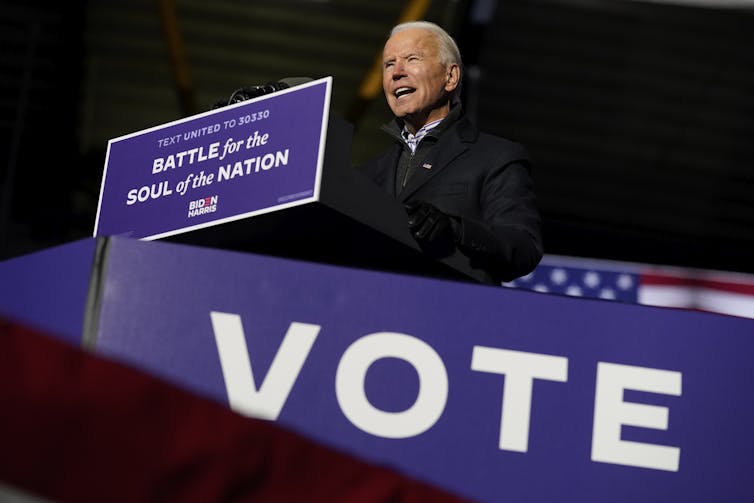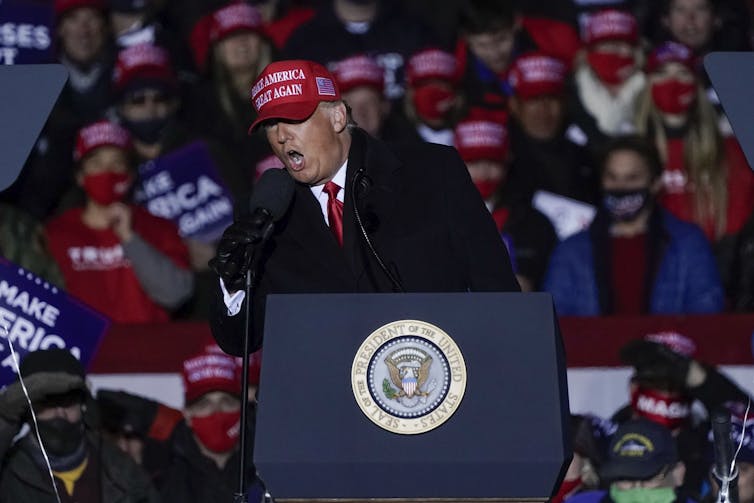Election day is finally here in the US. Here's what to expect
- Written by The Conversation
With an election taking place in the midst of a pandemic and an incumbent president committed to undermining[1] the integrity and legitimacy of the electoral process, voting day in the US is likely to be very different this year.
The most obvious difference is many Americans won’t actually be going to the polls because more than half of all voters have already cast their ballots, either by early in-person voting or mail-in voting.
How many people voted by mail?
According to the US Elections Project, some 99 million Americans[2] have already voted this year, more than 72% of the total votes cast in 2016.
And, notwithstanding President Donald Trump’s continual attempts to denigrate voting by mail, 64% of those early votes[3] have been mail-in ballots.
Over 92 million mail-in votes have been requested[4] in total this year and, as of the end of last weekend, around 28 million were still yet to be returned
This will undoubtedly delay the vote count in many states immediately after the election — meaning we may not have a clear winner today.
 If Biden ends up winning by a large margin on election night, the uncertainty will abate.
AP/Andrew Harnik
If Biden ends up winning by a large margin on election night, the uncertainty will abate.
AP/Andrew Harnik
Arrangements for processing and counting mail-in votes differ from state to state, as does the length of time after November 3 that mail-in votes can be received. The US Supreme Court has complicated matters by supporting a post-election day extension[5] in Pennsylvania and North Carolina, despite Republican attempts to block this. However, the court has denied any extra time for Wisconsin voters[6].
There are also massive problems with the capacity of the US Postal Service to deliver mail-in votes on time, due in no small part to Trump’s refusal to provide it with a bailout[7] earlier this year. In August, he even claimed he was opposed[8] to USPS funding increases because he didn’t want states to make it easier for Americans to vote by mail.
Because of the contentiousness of mail-in voting, which Trump claims without evidence will lead to widespread voter fraud, it will not be surprising if there are more lawsuits after the election over late vote counting. That, too, could delay the results even further.
Read more: US election: six swing states likely to decide who is the next president[9]
When would the Supreme Court get involved?
The Supreme Court has already been involved in this year’s election over deadlines for receipt of mail-in votes.
It is difficult to anticipate what other issues might reach the court by election day, but the Center for Public Integrity has identified[10] hundreds of court cases across the US related to voter identification laws, signatures on mail-in ballots, felony disenfranchisement and a host of other issues designed to restrict and suppress voting.
Trump’s most recent Supreme Court nominee, Amy Coney Barrett, reinforces its conservative majority. There has been much debate over whether she should recuse herself from any case that involves Trump’s re-election[11], but, so far, she has refused to answer that question.
There could be legal challenges to any recounts, particularly in close battleground states, but it is unlikely there will be a repeat of anything like the court’s intervention in the 2000 presidential contest[12]. Democrats now know what they need to do to sustain a constitutionally acceptable recount of votes.
 Trump has made an appeal for 50,000 volunteers to be present at polling locations to ‘monitor’ the vote.
Morry Gash/AP
Trump has made an appeal for 50,000 volunteers to be present at polling locations to ‘monitor’ the vote.
Morry Gash/AP
Why do exit polls matter?
The other thing to watch on election day are the exit polls. With fewer people voting in person, the exit polls could be less reliable than in normal years.
Why does this matter? Exit polls are a vital ingredient in the mix of data that television networks use to project the winner in each state and, ultimately, the winner of the election.
Edison Research, which conducts exit polling for the major television networks, has already adapted its polling techniques[13]] to accommodate the record numbers of early voters.
But with fewer voters exiting the polls, the networks will still need to be more cautious than usual when projecting the winner — especially if the contest is close and turns on the outcome in a handful of states.
Could there be violence?
Perhaps the most worrisome prospect is the spectre of violence on election day.
Trump has made an appeal for 50,000 volunteers[14] to be present at polling locations to “monitor” the vote, an unsavoury practice that has long been associated with voter intimidation and suppression in the US.
For various complex reasons, a US District Court judge ruled in 2018 that a previous agreement[15] between the two major parties not to intimidate or suppress minority voters could expire, which means the gloves are off this year.
According to a report in The Washington Post, Trump’s call for volunteers has prompted an enthusiastic response[16] from neo-Nazis and right-wing activists, leading many state election and law enforcement officials to prepare for voter intimidation, arrests and even violence on election day.
When will we know who won?
The unique characteristics of this year’s presidential election mean the outcome may still be uncertain on the evening of November 3 (early afternoon on November 4 in Australia). It is also possible it could take two or three days before the result is known in the key battleground states of Michigan, Pennsylvania and Wisconsin.
Trump won the presidency in 2016 by less than 80,000 votes in those three states[17].
 It is also possible it could take two or three days before the result is known in the key battleground states of Michigan, Pennsylvania and Wisconsin.
TRACIE VAN AUKEN.EPA
It is also possible it could take two or three days before the result is known in the key battleground states of Michigan, Pennsylvania and Wisconsin.
TRACIE VAN AUKEN.EPA
Democratic challenger Joe Biden is ahead in the polls in each of these states and, if he wins them, it is highly unlikely Trump will reach the 270 electoral votes needed to secure re-election.
If Biden ends up winning by a large margin on election night, the uncertainty will abate, as will the likelihood of any further legal challenges by Trump. But the prospect of this being apparent on election night is highly doubtful and the suspense of the 2020 presidential election may well continue for a few days more.
Read more: Who exactly is Trump's 'base'? Why white, working-class voters could be key to the US election[18]
Update: This story has been updated with the latest early voting and mail-in voting figures.
References
- ^ committed to undermining (abcnews.go.com)
- ^ 99 million Americans (electproject.github.io)
- ^ 64% of those early votes (electproject.github.io)
- ^ have been requested (electproject.github.io)
- ^ supporting a post-election day extension (www.nytimes.com)
- ^ denied any extra time for Wisconsin voters (www.washingtonpost.com)
- ^ Trump’s refusal to provide it with a bailout (www.politico.com)
- ^ claimed he was opposed (www.washingtonpost.com)
- ^ US election: six swing states likely to decide who is the next president (theconversation.com)
- ^ identified (publicintegrity.org)
- ^ case that involves Trump’s re-election (www.nytimes.com)
- ^ 2000 presidential contest (www.history.com)
- ^ adapted its polling techniques (news.radio-online.com)
- ^ appeal for 50,000 volunteers (abcnews.go.com)
- ^ previous agreement (www.theatlantic.com)
- ^ prompted an enthusiastic response (www.washingtonpost.com)
- ^ less than 80,000 votes in those three states (www.washingtonpost.com)
- ^ Who exactly is Trump's 'base'? Why white, working-class voters could be key to the US election (theconversation.com)
Read more https://theconversation.com/election-day-is-finally-here-in-the-us-heres-what-to-expect-148998

















